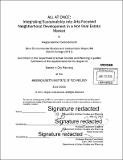| dc.contributor.advisor | Lawrence Susskind. | en_US |
| dc.contributor.author | Fonda-Bonardi, Allegra Gentile | en_US |
| dc.contributor.other | Massachusetts Institute of Technology. Department of Urban Studies and Planning. | en_US |
| dc.date.accessioned | 2015-09-29T19:02:08Z | |
| dc.date.available | 2015-09-29T19:02:08Z | |
| dc.date.copyright | 2015 | en_US |
| dc.date.issued | 2015 | en_US |
| dc.identifier.uri | http://hdl.handle.net/1721.1/99082 | |
| dc.description | Thesis: M.C.P., Massachusetts Institute of Technology, Department of Urban Studies and Planning, 2015. | en_US |
| dc.description | Cataloged from PDF version of thesis. | en_US |
| dc.description | Includes bibliographical references (pages 147-151). | en_US |
| dc.description.abstract | Cities with industrial legacies often seek to redevelop former brownfield sites into opportunities for economic growth. Some of these same cities are also attempting to promote neighborhood-scale arts-oriented development for that same purpose. In this research, I explore whether and how cities with both rapidly intensifying real estate markets and a growing creative economy promote neighborhood-scale arts-oriented development projects. My research is based on the premise that integrating city-wide environmental, social, and economic sustainability into these projects is more likely to create civic spaces that meet the competing longterm interests of multiple stakeholder groups than projects focused on meeting contending needs in separate, dissociated locations. Based on a year-long study of the ARTFarm for Social Innovation in Somerville, Massachusetts, I examine the challenges of implementing mutually reinforcing environmental remediation, arts-based development, and sustainability in a rapidly intensifying real estate market. I base my analysis on key informant interviews, close readings of site planning documents, and other data gathered as a participant-observer at planning meetings. To date, ambiguous land use tenure agreements and a narrow focus on integration within the bounds of a 2.2 acre site have eroded the ARTFarm's ability to pursue multidimensional sustainability and meet stakeholder interests. I conclude that projects like the ARTFarm could act as a staging area and home base for sustainability initiatives and programming on a network of sites rather than being confined to activities on specific and consequentially often problematic sites. Cities could use these projects as the context to enlist private developers to help fund remediation by ensuring that a portion of the remediated land gets returned to the public for well-planned environmental and social uses. Shifting to a coordination role enables ARTFarm to deploy a distributed network of urban experiments that seek creative ways to optimize sustainability objectives on publicly owned land. | en_US |
| dc.description.statementofresponsibility | by Allegra Gentile Fonda-Bonardi. | en_US |
| dc.format.extent | 173 pages | en_US |
| dc.language.iso | eng | en_US |
| dc.publisher | Massachusetts Institute of Technology | en_US |
| dc.rights | M.I.T. theses are protected by copyright. They may be viewed from this source for any purpose, but reproduction or distribution in any format is prohibited without written permission. See provided URL for inquiries about permission. | en_US |
| dc.rights.uri | http://dspace.mit.edu/handle/1721.1/7582 | en_US |
| dc.subject | Urban Studies and Planning. | en_US |
| dc.title | ALL AT ONCE : integrating sustainability into arts-focused neighborhood development in a hot real Estate market | en_US |
| dc.title.alternative | Integrating sustainability into arts-focused neighborhood development in a hot real Estate market | en_US |
| dc.type | Thesis | en_US |
| dc.description.degree | M.C.P. | en_US |
| dc.contributor.department | Massachusetts Institute of Technology. Department of Urban Studies and Planning | |
| dc.identifier.oclc | 921890845 | en_US |

